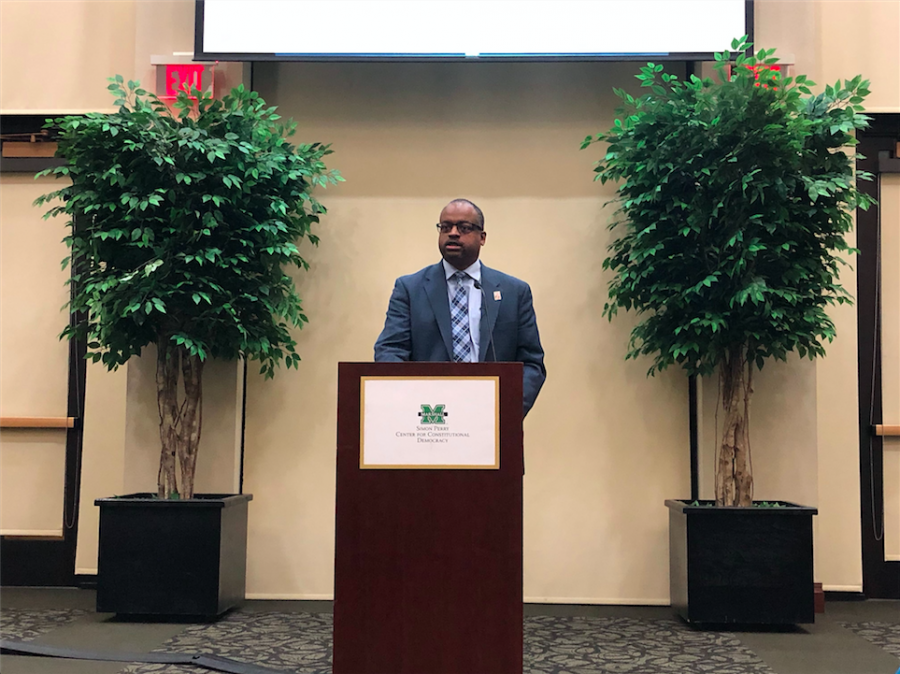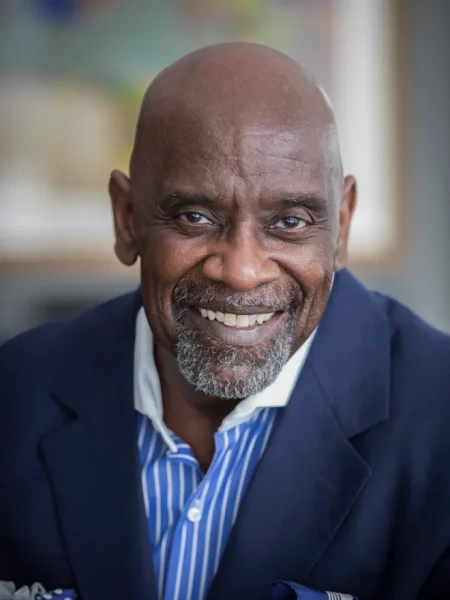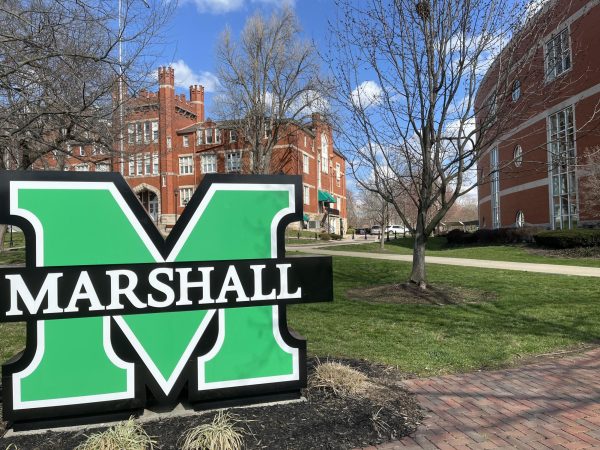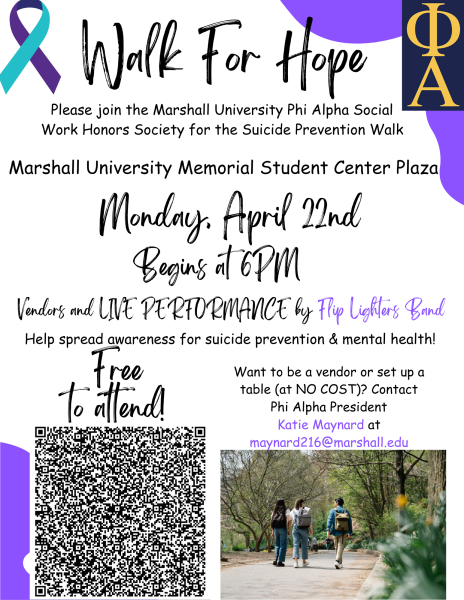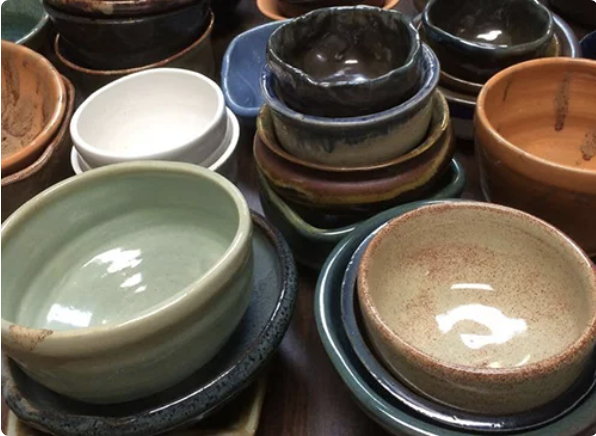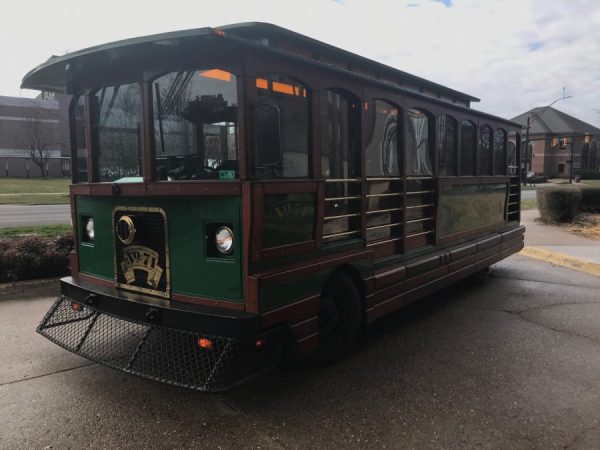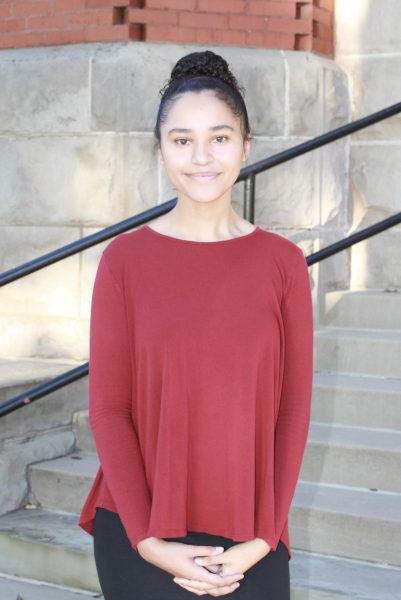Federal judge lectures on National Museum of African American History and Culture
Judge Robert L. Wilkins, who was the first speaker of the semester in the Amicus Curiae Lecture Series on Constitutional Democracy, looks back at the crowd during lecture.
The 100-year mission to create the Smithsonian Institution’s National Museum of African American History and Culture began as a way to honor black veterans of the American Civil War who were excluded during a 1915 veterans celebration, an author and federal judge said Tuesday in Marshall University’s Brad D. Smith Foundation Hall.
“That Colored Citizens Committee that raised the money to try to entertain the black veterans who had come in 1915 decided that they should do more, that they should take the money that they had leftover and form a new nonprofit organization whose purpose it would be to construct some sort of a permanent physical monument or memorial in Washington D.C. that honored African American soldiers and sailors so that their contributions could never be forgotten,” said Judge Robert L. Wilkins of the United States Court of Appeals for the District of Columbia Circuit, while giving a lecture in the Amicus Curiae Lecture Series on Constitutional Democracy.
Wilkins, who was chairman of the site and building committee of the Presidential Commission established by Congress to plan the National Museum of African American History and Culture, said black veterans faced segregation when they were invited to march in a parade reenacting the Grand Review of the Armies, a parade that had originally taken place in Washington D.C. to honor union soldiers following the Civil War.
Wilkins said none of the over 180,000 African American combat soldiers who had served in the United States Colored Troops during the war had been invited to participate in the original Grand Review of the Armies, and the few black soldiers included in the parade, soldiers who did not serve in combat but served in other ways, were treated as “comic relief” instead of “heroes who helped to save the republic.”
During the 1915 reenactment of the Grand Review of the Armies, black veterans were allowed to be in the parade, but were barred from balls, banquets and tours the white veterans were allowed to attend. Wilkins said this led to the creation of the Colored Citizens Committee, which helped to provide the black veterans entertainment and housing during the reenactment and later worked to get them recognition by forming a nonprofit organization called the National Memorial Association in 1916 with the goal of having a permanent physical monument or memorial in Washington D.C.
Though the original plan was to erect a monument to African American soldiers and sailors, the scope of the project expanded as the National Memorial Association realized African Americans had contributed to the country in other ways as well, Wilkins said.
“Within a couple of years, that National Memorial Association realized that, well, there had been African American contributions to the United States in education, business, in the arts, in inventions, you name it, and so, what we really should do is construct a national memorial building to negro achievement and contributions to America, essentially a national museum of African American history and culture,” Wilkins said. “And they hired a black architect from New York named E.R. Williams to envision and design such a building.”
Wilkins said members of the National Memorial Association worked hard to get legislation introduced to construct this national memorial building to negro achievement, but were mocked by several members of Congress, some of which said, “there is no such thing as negro achievement.”
It wasn’t until 1929 that legislation approved by both houses of Congress and signed by President Calvin Coolidge authorized the construction of this national memorial building to negro achievement. Even then, Wilkins said, there was a catch, as funding for the project was stripped in the process of the bill going through Congress, and it was passed with no funding. Wilkins said that March of 1929 was not a good time to begin a project like this, as the stock market crash would happen in October, bringing the Great Depression and essentially dooming the project.
In the ensuing years, he said, people involved with the project died and “pretty much the whole effort” was forgotten by the 1960s, when another push for recognition took place.
Wilkins said in the 1960s, civil rights was going full force and there was interest in black history, black power and black self-expression, which resulted in an interest in creating African American museums. He said an individual who took over for Dr. Carter G. Woodson as the executive director of the “Association for the Study of Negro Life and History” testified before Congress in 1968 urging Congress to create a national institute or national museum dedicated to the study of African American history and culture, and several famous individuals, such as James Baldwin and Jackie Robinson, testified before Congress in support of such an institution during a hearing.However, Congress did not pass the legislation.
Still another push for a national museum dedicated to African American history, specifically in Washington D.C., led the Smithsonian Institution to create a commission by the end of the 1980s to study if they should create such a national museum, Wilkins said. The commission ended up encouraging the creation of the museum, and the Smithsonian Board of Regents agreed to create such an institution.
Wilkins said there were efforts to create the museum, but once again, Congress was a challenge. It passed the senate in 1992, but failed in the House, and another attempt in 1994 passed in the House, but failed in the senate. The legislation was not able to make its way through Congress until 2003, when it passed with bipartisan support, Wilkins said.
“But there was a catch,” Wilkins said. “The catch was that we unanimously thought the museum should go on the National Mall, and we recommended two potential spaces for it, but the National Parks Service and others said that they thought that the Mall was full.”
Because of this opposition, Wilkins said, the decision of where to put the museum was left up to the Smithsonian Board of Regents. In 2006, the Smithsonian Board of Regents made the decision to put the museum across the street from the National Museum of American History, and the groundbreaking ceremony for the museum took place in 2012, Wilkins said. When the National Museum of African American History and Culture opened in 2016, the 100-year mission described in the title of Wilkins lecture, “A Journey Down the Long Road to Hard Truth: The 100-Year Mission to Create the National Museum of African-American History and Culture,” was finally complete.
Following the lecture, Wilkins said he thinks it is important to speak about the museum because the story of how it came to be is an important American story of people coming together and putting the interests of the nation first before their own political interests. He said he thinks it is a story of people who felt that an institution like this museum was needed to help heal from the country’s racial discord and discrimination.
Wilkins also said he would like people to remember that Black History Month is celebrated not just to learn some facts or figures about individuals, but in order to recognize that African Americans have contributed and to acknowledge their humanity, their equality and right to equal citizenship.
Burnis Morris, director of the Dr. Carter G. Woodson Lyceum, which co-sponsored the event along with the Simon Perry Center for Constitutional Democracy, said he thinks people should have taken away from Wilkins’ lecture that it was a long struggle to get the museum open and took the efforts of many people over several generations to accomplish something that should have been easy to do right from the start.
Following the lecture, Morris presented Wilkins with a Dr. Carter G. Woodson Lyceum award.
Jesten Richardson can be contacted at [email protected].
Your donation will help continue the work of independent student journalism at Marshall University. If you benefit from The Parthenon's free content, please consider making a donation.


